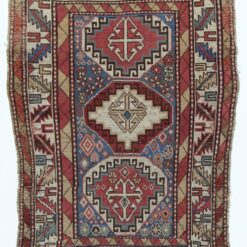Antique Persian Caucasian Kazak Rugs
Kazak according to Latimov refers to a district and its center town located between the borders of the Azerbaijan Republic towards the northwest into the Republic of Georgia and towards the southwest into the Republic of Armenia. The city of Kasak lies 290 miles west of Baku. Antique Kazak rugs are among the finest of all antique rugs. Renowned for their incredible tribal characteristics, these rugs are sought after by collectors the world over.
Construction: The warp of Kazak rugs is of sheep wool, not dyed, rather dark ivory, sometimes camel hair is said to be used. The weft is of wool, or a blend of wool and camel hair. Sometimes wool and cotton threads are only slightly plied together to form the warp thread. Wefts are dyed mostly in light red, wefts in dark blue distinguish the Kazak from Karabakh rugs. 2–6 wefts are shot in after each row of knots. The pile is wool, sometimes undyed camel hair, the knots being symmetrical, the warps not depressed. Kazak rugs are woven more coarsely, their pile being 1–2 cm high. The upper end is fastened with a 1–4 cm wide woolen tapestry weave in red colors. The lower end is often finished like the upper end, but uncut warp loops are often seen protruding from the flat-woven end. Selvedges are nearly always flat and between 1–2 cm wide, consisting of two ribs in figure-of-eight wrapping with supplemental threads, these often in different colors. In most cases, two double warps are wrapped three times.
Sizes: Kazak rugs were predominantly made in traditional sizes. Runners of this size were seldom woven in this tribal village. The most common size was 4’ x 6’ and 5’ x 7’…
Patterns: Unlike other antique rug styles, in many 19th century Kazak carpets, large archetypal motifs dominate the field, with majestic proportions that magnify the powerful effect of these iconic designs.
Colors: Kazak rugs have a limited color palette of 5–7 colors. In general, the field has a red background, less frequently also ivory, green, blue, or yellow, the color of the main border often in contrasting colors. The color of the main borders is often difficult to identify due to the dense ornamentation. Kazak rugs woven before ca. 1910 have more intense and bright colors than rugs woven after this year.




